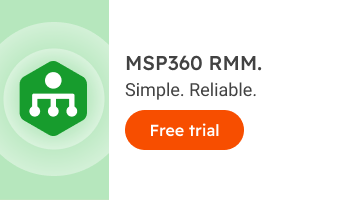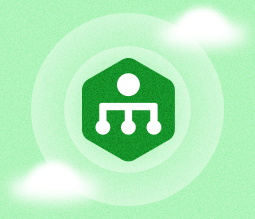MSP Business
What is RMM? Remote Monitoring and Management Basics
Remote monitoring and management, or RMM, tools make MSPs’ jobs more efficient by helping them take a more proactive approach to monitoring and administering the various systems that they manage. RMM solutions also enable automation, which allows MSPs to work faster and operate more effectively at scale.
This article provides an overview of RMM, including what it is, what benefits it offers, and how to use RMM as part of your MSP strategy.
What is RMM?
Remote monitoring and management is an approach to IT management that relies on pre-installed tools for monitoring and managing IT systems resources from any location.
An RMM tool could be an application that lets you log in remotely to a server, or it could be a tool that collects data about the server and streams it to a central dashboard where you can monitor all of your servers.
With RMM software, managed service providers can remotely monitor and manage client endpoints, networks, and computers from a distance.
In many cases, MSPs deploy RMM platforms that combine multiple types of RMM functionality – remote logins, remote monitoring, remote administration, and more – into a single product suite.
Key Features of RMM Tools
Remote monitoring and management software unlocks a wide variety of features that make it simple for your IT staff to effortlessly monitor and manage complex IT assets.
Real-time monitoring
Real-time client system monitoring ensures that a system remains protected against vulnerabilities and is operating efficiently. Every device connected to the client's system must have an RMM app installed. This way, all devices connected to the client's network will appear in a single management dashboard under the managed devices section. MSPs can monitor their performance in real time and install software updates as and when needed. In simple words, software deployment and checking network health status becomes easy. This real-time monitoring of the client base helps your team leader know what's happening all across the organization's system.
System alerts
Imagine that a device in your client’s network system encounters an S.M.A.R.T or antivirus issue. In such a scenario, RMM swiftly sends alerts to system administrators and MSPs, enabling them to promptly address potential issues, ranging from incorrect system time to high disk space usage. This software provides immediate solutions, ensuring that your organization experiences minimal downtime. MSPs can even receive real-time push notifications on their mobile devices, enhancing their sense of security and preparedness.
IT automation and scripting
If you want to save time, you can head to the script library on the RMM software dashboard. Run scripts to automate tasks such as cache cleanup, restarting the system, enabling/disabling WakeOnLAN, etc. This automation boosts your work efficiency and helps you manage multiple devices simultaneously.
Patch management
Another feature that makes the RMM tool quite valuable for MSPs is that this software will manage and install security patches, driver updates, and software updates. It will keep complete track of patch runs on your system.
Further reading Patch Management With MSP360 RMM
Reporting and analytics
The RMM tool unlocks customized reports about software inventory, patch history, and system health. Stakeholders can use these reports to make informed decisions based on data, and IT staff can use them as a document for billing purposes.
AI-Powered RMM
If you install AI-powered RMM software, it will help you with proactive maintenance. This tool can quickly analyze historical data and patterns and easily predict potential issues that need a quick fix. Once you know which areas have problems, you can easily find their solution to prevent downtime. Since this tool is driven by artificial intelligence, it can quickly remediate routine issues. There won't be any need for manual intervention for handling routine maintenance tasks. As a result, you will experience a boost in the work efficiency of your IT staff.
Benefits of RMM
RMM offers a range of benefits across different areas of a managed services workflow.
Monitoring and centralized management
RMM software allows your team to monitor systems 24/7 through a centralized dashboard. You don’t have to check each system individually to track its status.
What’s more, because RMM tools work in the background, they collect monitoring data automatically, without disturbing your customers.
Further reading RMM: What Do MSPs Need to Monitor?
Faster Support
With RMM tools, you can provide support from anywhere, regardless of where you or your customers are located. You can also easily support multiple customers at once from a central office.
Further reading The Benefits of Remote Support
Automation
RMM tools make it easy to build automated workflows by, for example, setting up automated alerts for monitoring tools, automatically creating tickets to handle support requests, and using scripts to automate incident resolution. Thanks to its professional services automation feature, your IT staff needs to spend less time on the support desk.
In this document, you'll find a PowerShell script that checks the status of the services listed below and sends an email alert if any of them is turned off:
- Windows Firewall
- Windows Defender
- Windows Update Service
- Any installed third-party antivirus

Reporting
Benefits of RMM also include transparent reporting. Using the data collected by RMM tools, you can create various types of reports about your clients’ systems. For example, you can automatically generate data about how many times you logged in via this remote management software to provide support or how many alerts a client’s system experienced in a given time period.
Simplicity and Transparency
By consolidating monitoring and management operations into a single platform, RMM tools simplify MSP tasks. They also make information more accessible to anyone on your team who needs it.
Scalability
RMM tools are critical for scaling MSP operations. By automating workflows and making it easier to support clients spread across a large area, RMM helps your business grow.
Increased Productivity
RMM tools help your technicians investigate issues faster without having to travel to remote sites. In turn, they increase productivity.
Further reading Core RMM Software Features
Why MSPs Need RMM
RMM tools offer so many benefits that it’s difficult to imagine a successful MSP business operating today without the help of RMM.
RMM plays a vital role in helping MSPs make the jump from a break/fix model to offering proactive managed services. With RMM, it becomes much easier to monitor and manage your clients’ systems on an ongoing, continuous basis. You can identify and fix problems before your customers even know about them.
In addition, RMM helps you deliver more secure managed services. RMM monitoring and security tools can detect threats automatically. You may even be able to use scripts to automate security incident resolution by, for example, blacklisting an IP address that is generating malicious traffic.
RMM reduces downtime, too. By enabling you to find and fix issues proactively, RMM means fewer disruptions for your customers.
Finally, as your customers’ needs change or you seek to offer new types of managed services, RMM provides the flexibility to help you do so. When you spend less time traveling to remote sites or fixing problems manually, you are in a stronger position to offer more services to more customers.
Further reading RMM Security for MSPs: Vulnerabilities and Best Practices
RMM and MSP Profitability
There are hard financial reasons to adopt RMM, too.
Traveling wastes not only time but also money. RMM can improve your operating margins by reducing how much you spend on travel.
RMM platforms that integrate a variety of tools into one suite can also reduce your tool costs. They eliminate the need to pay for separate monitoring tools, remote login solutions, and so on.
By making your technicians more productive, RMM will reduce your labor costs, which may be the single most important factor in boosting your MSP business’s profitability.
Further reading Guide to MSP Profitability
Selling RMM-based Solutions to Customers
The benefits of RMM may be clear to you as an MSP but less obvious to your customers. They often want the cheapest service model rather than one that includes proactive services via RMM tools.
To help customers understand the value of the types of services that RMM enables, emphasize:
- Faster results: Automation and remote support mean your customers get what they need from you sooner.
- Proactive service: Ongoing, continuous management via RMM eliminates the need for customers to monitor systems or make changes on their own.
- Minimal disruptions: RMM helps you deliver managed services with minimal disruptions to your customers. You don’t need to send staff on-site or sit at their desks.
- Self-service: In some cases, you may choose to use RMM tools to let customers check the status of their systems on their own. For example, you could give them access to monitoring data from RMM tools.
Conclusion
Before any final words, visit some of our most popular articles, like Exchange Online vs. Exchange On-Premises, what is backup software, immutable backups, cost-effective backup solutions, why Amazon's EC2 and S3 are fundamentally different types of service, how to resize partitions in Linux, how to retrieve Amazon Access Key ID and AWS Secret Access Key and an overview of SQL server backup types.
From faster support to more efficient troubleshooting to less downtime, RMM offers MSPs and their customers a range of benefits. Whether you’re building a new MSP business from scratch or looking for ways to optimize your existing business, RMM should be a part of your strategy.


